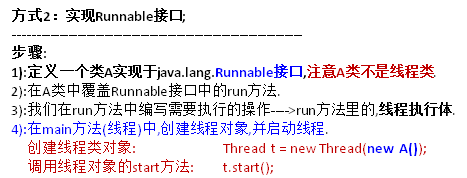进程是指,在内存中运行的应用程序,每个进程都有自己独立的一块内存空间,一个应用程序可以同时启动多个进程。

另外:
1.进程
代码示例:进程的操作
1 package org.wanglei._02process; 2 3 public class ProcessDemo { 4 5 /** 6 * 操作进程,用了两个方法。 7 * @param args 8 * @throws Exception 9 */ 10 public static void main(String[] args) throws Exception { 11 //方法一:使用了Runtime类的exec方法 12 Runtime rt = Runtime.getRuntime(); 13 rt.exec("notepad"); 14 //方法二:使用了ProcessBuilder类的start方法 15 ProcessBuilder pb = new ProcessBuilder("notepad"); 16 pb.start(); 17 18 } 19 20 }
2.线程
创建和执行线程的两种方式:


两种方式的区别:

总结:实现方式可以共享同一个资源,继承方式不行。
但是:必须保证线程同步,才可以正常共享一个资源。

方法2的语法:

注意一点:

使用synchronized时,尽量减少作用域!

1 package com.wang.syn; 2 3 class Syn { 4 5 public void testSyn() { 6 synchronized (Syn.class) { 7 System.out.println(Thread.currentThread().getName() + " start..."); 8 try { 9 Thread.sleep(1000); 10 } catch (Exception e) { 11 e.printStackTrace(); 12 } 13 System.out.println(Thread.currentThread().getName() + " end..."); 14 } 15 } 16 } 17 18 class MyThread implements Runnable { 19 20 @Override 21 public void run() { 22 Syn s = new Syn(); 23 s.testSyn(); 24 } 25 26 } 27 28 public class Main { 29 30 public static void main(String[] args) { 31 for (int i = 0; i < 3; i++) { 32 MyThread myThread = new MyThread(); 33 new Thread(myThread).start(); 34 } 35 } 36 }
Thread-1 start...
Thread-1 end...
Thread-0 start...
Thread-0 end...
Thread-2 start...
Thread-2 end...
以上代码中,可以保证线程同步。
线程优先级代码示例:
1 package operate_thread; 2 class PriorityThread extends Thread{ 3 public PriorityThread(String typeName) { 4 super(typeName); 5 } 6 7 public void run() { 8 for (int i = 0; i < 10; i++) { 9 System.out.println(super.getName() + i); 10 } 11 } 12 } 13 public class PriorityDemo { 14 15 /** 16 * @param args 17 */ 18 public static void main(String[] args) { 19 PriorityThread max = new PriorityThread("高优先级"); 20 max.setPriority(Thread.MAX_PRIORITY); 21 22 PriorityThread min = new PriorityThread("低优先级"); 23 min.setPriority(Thread.MIN_PRIORITY); 24 25 min.start(); 26 max.start(); 27 28 29 } 30 31 }
低优先级0
高优先级0
低优先级1
高优先级1
低优先级2
高优先级2
低优先级3
高优先级3
低优先级4
高优先级4
低优先级5
高优先级5
低优先级6
高优先级6
高优先级7
高优先级8
高优先级9
低优先级7
低优先级8
低优先级9
----------------------------------
同步锁代码演示:
1 package com.wang.lock; 2 3 import java.util.concurrent.locks.Lock; 4 import java.util.concurrent.locks.ReentrantLock; 5 6 public class LockDemo implements Runnable { 7 8 /** 9 * 演示同步锁lock 10 * @param args 11 */ 12 public static void main(String[] args) { 13 LockDemo lockDemo = new LockDemo(); 14 new Thread(lockDemo).start(); 15 new Thread(lockDemo).start(); 16 new Thread(lockDemo).start(); 17 } 18 19 private int num = 50; 20 private final Lock lock = new ReentrantLock(); 21 22 @Override 23 public void run() { 24 for (int i = 0; i < 50; i++) { 25 use(); 26 } 27 } 28 29 private void use() { 30 lock.lock(); 31 try { 32 if (num > 0) { 33 System.out.println(Thread.currentThread().getName() + "使用了一张票" 34 + num); 35 Thread.sleep(100); 36 num--; 37 } 38 } catch (Exception e) { 39 e.printStackTrace(); 40 } finally { 41 lock.unlock(); 42 } 43 } 44 45 }
Thread-0使用了一张票50
Thread-0使用了一张票49
Thread-0使用了一张票48
Thread-0使用了一张票47
Thread-0使用了一张票46
Thread-0使用了一张票45
Thread-0使用了一张票44
Thread-0使用了一张票43
Thread-0使用了一张票42
Thread-1使用了一张票41
Thread-1使用了一张票40
Thread-2使用了一张票39
Thread-2使用了一张票38
Thread-0使用了一张票37
Thread-0使用了一张票36
Thread-0使用了一张票35
Thread-0使用了一张票34
Thread-0使用了一张票33
Thread-0使用了一张票32
Thread-0使用了一张票31
Thread-0使用了一张票30
Thread-0使用了一张票29
Thread-0使用了一张票28
Thread-0使用了一张票27
Thread-0使用了一张票26
Thread-0使用了一张票25
Thread-0使用了一张票24
Thread-0使用了一张票23
Thread-0使用了一张票22
Thread-0使用了一张票21
Thread-0使用了一张票20
Thread-0使用了一张票19
Thread-0使用了一张票18
Thread-0使用了一张票17
Thread-0使用了一张票16
Thread-0使用了一张票15
Thread-0使用了一张票14
Thread-0使用了一张票13
Thread-0使用了一张票12
Thread-0使用了一张票11
Thread-0使用了一张票10
Thread-0使用了一张票9
Thread-0使用了一张票8
Thread-0使用了一张票7
Thread-0使用了一张票6
Thread-0使用了一张票5
Thread-0使用了一张票4
Thread-0使用了一张票3
Thread-1使用了一张票2
Thread-1使用了一张票1
3.线程通信
举一个生产者和消费者的案例。
1.首先需要保证,生产者的生产动作、消费者的消费动作独立进行,两者不受干扰,就得使用同步操作;
2.还需要保证,生产者和消费者交替进行,就得使用等待和唤醒机制。

同步锁:

所以,线程之间的通信:使用wait()和notify()方法————被线程共享的X对象来调用(this)
示例代码:
Resource:
package com.wl.thread; public class Resource { private String name; private String gender; private boolean isEmpty = true; public synchronized void push(String name, String gender) { try { while (!isEmpty) { this.wait();// 此时有数据,则让生产者线程wait,释放同步锁,等待消费者消费 } this.name = name; Thread.sleep(100); this.gender = gender; isEmpty = false; this.notify();// 生产完毕后去唤醒消费者 } catch (InterruptedException e) { e.printStackTrace(); } } public synchronized void popup() { try { while (isEmpty) { this.wait(); } Thread.sleep(100); System.out.println(this.name + "-----" + this.gender); isEmpty = true; this.notify(); } catch (Exception e) { e.printStackTrace(); } } }
producer:
1 package com.wl.thread; 2 3 public class Producer implements Runnable { 4 private Resource r = null; 5 6 public Producer(Resource r) { 7 super(); 8 this.r = r; 9 } 10 11 @Override 12 public void run() { 13 for (int i = 0; i < 20; i++) { 14 if (i % 2 == 0) { 15 r.push("A", "1"); 16 } else { 17 r.push("B", "2"); 18 } 19 } 20 } 21 }
consumer:
1 package com.wl.thread; 2 3 public class Consumer implements Runnable { 4 5 private Resource r = null; 6 7 public Consumer(Resource r) { 8 super(); 9 this.r = r; 10 } 11 12 @Override 13 public void run() { 14 for (int i = 0; i < 20; i++) { 15 r.popup(); 16 } 17 } 18 }
App:
1 package com.wl.thread; 2 3 public class App { 4 5 /** 6 * @param args 7 */ 8 public static void main(String[] args) { 9 Resource r = new Resource(); 10 Thread t = new Thread(new Producer(r)); 11 t.start(); 12 Thread t2 = new Thread(new Consumer(r)); 13 t2.start(); 14 } 15 }
A-----1
B-----2
A-----1
B-----2
A-----1
B-----2
A-----1
B-----2
A-----1
B-----2
A-----1
B-----2
A-----1
B-----2
A-----1
B-----2
A-----1
B-----2
A-----1
B-----2
-------------------------------------达到了同步并且交替执行
lock的线程通信:

总结:使用condition.await() condition.signal()替换



